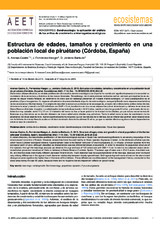Estructura de edades, tamaños y crecimiento en una población local de piruétano (Córdoba, España)
Structure of ages, sizes and growth in a local population of the Iberian wild pear (Cordoba, Spain)
Autor
Arenas Castro, Salvador
Jordano Barbudo, Diego
Fernández Haeger, Juan
Editor
Asociación Española de Ecología TerrestreFecha
2015Materia
Anillos de los árbolesCrecimiento radial
Dendroecología
Dinámica de poblaciones
Pyrus bourgaeana
Free rings
Radial-growth
Dendroecology
Population dynamic
METS:
Mostrar el registro METSPREMIS:
Mostrar el registro PREMISMetadatos
Mostrar el registro completo del ítemResumen
Durante las últimas décadas, la notable proliferación de estudios dendrocronológicos en España ha contribuido significativamente al avance del conocimiento
de la estructura y dinámica de las masas forestales. Sin embargo, las investigaciones realizadas se han centrado principalmente en especies
de mayor interés forestal, en detrimento de otras que sin embargo presentan un notable interés ecológico. Un caso paradigmático es el
piruétano (Pyrus bourgaeana, D), especie virtualmente desconocida desde el punto de vista ecológico, aunque tipificada como especie característica
de los ecosistemas Mediterráneos. Con objeto de describir la estructura poblacional de esta especie, a través del análisis de los anillos de los árboles
obtuvimos la edad y tamaño de 122 individuos con DAP > 5 cm, localizados en dos zonas adyacentes (olivar abandonado y dehesa de encinas) en
Sierra Morena (Córdoba, España). La edad media de los individuos fue de ≈ 37±12 años, siendo el más longevo de 80 años, y el tamaño de los árboles
fue muy variable, entre 10 y 35 cm. El diámetro del tronco no fue un buen predictor de la edad de los árboles, ya que incluso encontramos diferencias
muy llamativas en la relación diámetro de tronco-edad entre árboles muy próximos. Tanto la edad como la tasa de crecimiento de los
piruétanos del olivar abandonado, fueron significativamente mayores que en los árboles de la dehesa. Estas diferencias podrían estar relacionadas
con la historia de manejo llevada a cabo en el área de estudio durante los últimos 50 años, ya que no existen efectos negativos denso-dependientes
sobre la tasa de crecimiento In recent decades, the remarkable proliferation of dendrochronological studies in Spain has contributed significantly to advancing knowledge of the
structure and dynamics of forests. However, researches have focused mainly on forest species of greatest interest, to the detriment of other species
which have a greater ecological interest. A paradigmatic case is the Iberian wild pear (Pyrus bourgaeana, D), a virtually unknown species from the
ecological point of view, although classified as characteristic species of Mediterranean ecosystems. In order to describe the population structure of
this species, through the tree-rings analysis we obtained the age and size of 122 individuals with DBH > 5 cm, located in two adjacent areas (abandoned
olive grove and meadows of Oaks or dehesa) in Sierra Morena (Cordoba, Spain). The mean age of trees was ≈ 37±12 years, the oldest was
80, and the tree sizes were highly different, between 10 and 35 cm. Trunk diameter was not a good predictor of the tree-age, because even we found
very striking differences in the age and trunk diameter relationship between closely spaced trees. Both age and growth-rates of trees in the abandoned
olive grove were significantly higher than in the trees of the Dehesa. These differences could be related to the management history conducted in the
study area during the last 50 years, because there are no negative density-dependent effects on growth-rates

